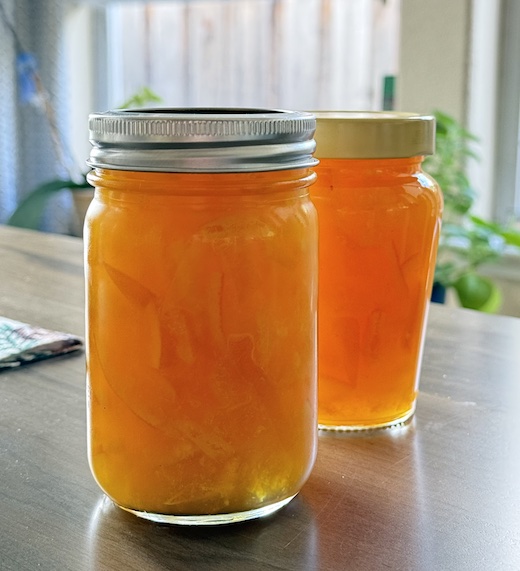Wash the lemons thoroughly and discard the stems.
Cut each lemon into quarters and then slice each quarter into thin slices, about a 1/4” thick. Save the seeds from the lemons in a separate bowl. We will be using them to help set the marmalade.
Cover the lemons with water. The ratio of lemons to water is 1:1 by weight.
Transfer the seeds to a tea strainer and stick the strainer into the lemon and water mixture being careful to make sure the seeds stay inside the strainer. Alternatively, you can use the muslin to make a bundle with the seeds and add it to the bowl with the lemons and water.
Cover the bowl and set aside on the counter for 6-8 hours, or overnight. This soaking time helps the seeds release their pectin, and is essential for setting the marmalade naturally.
Measure out the sugar into a bowl and set aside.
Remove the strainer (or muslin bundle) after 8 hours and using your fingers press all the jelly like natural pectin from the seeds into the lemon and water mixture.
Make sure to extract the pectin thoroughly before discarding the seeds.
Transfer the lemon mixture to the saute pan and bring to a low boil.
Lower the heat and simmer the lemons for 45-60 minutes covered until they are completely soft. Stir a few times to make sure nothing sticks to the bottom.
Taste a piece of lemon before proceeding to the next step. If it has a bit of bite left, continue to simmer for a few more minutes. Undercooked lemons will result in chewy pieces of rind in the marmalade.
Add all but a cup of sugar to the lemons.
Stir to dissolve the sugar completely. Once the sugar has turned into a syrup, taste a tiny bit of the lemon mixture. Careful, it will be very hot. Add a little more of the reserved sugar and taste again if you feel the lemon is still too bitter. This is a matter of preference, so taste a few times and adjust the sweetness of the marmalade to your liking.
If you like a brighter yellow color, add a pinch of turmeric. For a more orange hue, add crushed saffron.
Now bring the mixture to a hard boil until it reaches a temperature of 215F, or the gelling stage. Stir frequently to prevent the marmalade from catching.
If you don’t have a thermometer, the best way to check for the gelling stage is to do the crinkle test. Spoon a little bit of the marmalade on to a cold plate. After a couple minutes, using your finger ‘push’ the marmalade. If the surface crinkles, the marmalade is ready. Otherwise, continue to cook for a few more minutes and test again.
Make sure you move the pan off the heat while you are doing a crinkle test, so the marmalade doesn’t overcook.
Take the marmalade off the fire and let it rest for 10 minutes. This resting time is important to prevent the rinds from floating at the top when you ladle the marmalade into glass jars.
After 10 minutes, ladle the marmalade carefully into the glass jars all the way up to the top. Tap on the counter gently to release any air bubbles.
Leave the jars uncovered overnight on the counter to cool completely and set. Do not stir or touch the marmalade at this stage since this will interfere with the setting process.
The next day, the marmalade should be set with pieces of lemon suspended throughout the jar.
Your marmalade is ready to enjoy! Cover and store in the refrigerator for a few weeks, or even months.
